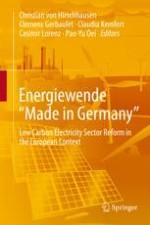2018 | OriginalPaper | Chapter
4. Greenhouse Gas Emission Reductions and the Phasing-out of Coal in Germany
Author : Pao-Yu Oei
Published in: Energiewende "Made in Germany"
Publisher: Springer International Publishing
Activate our intelligent search to find suitable subject content or patents.
Select sections of text to find matching patents with Artificial Intelligence. powered by
Select sections of text to find additional relevant content using AI-assisted search. powered by
